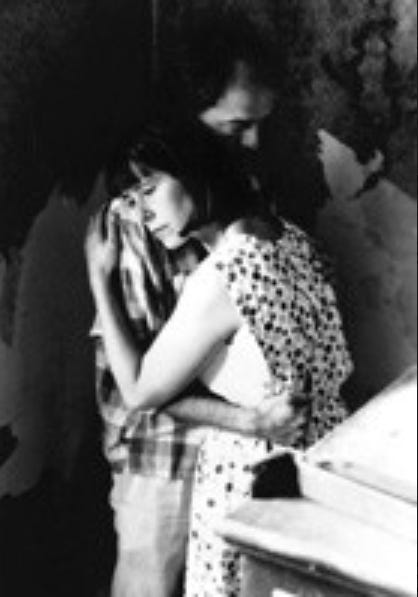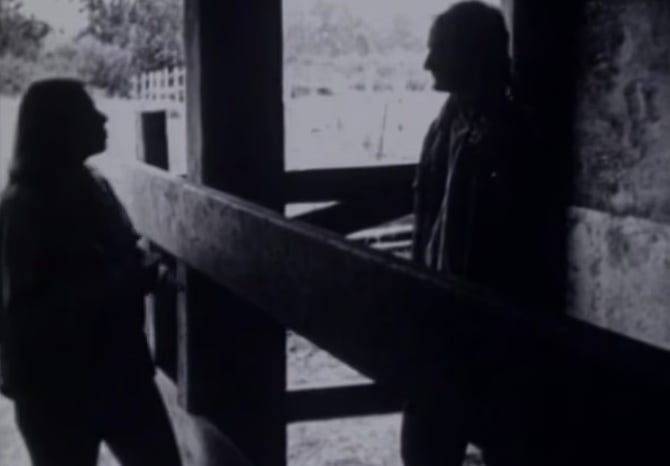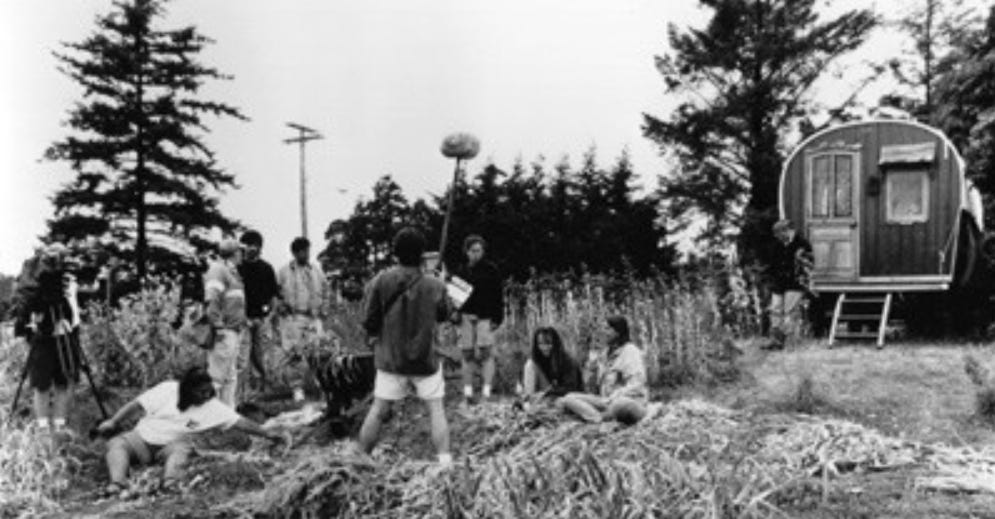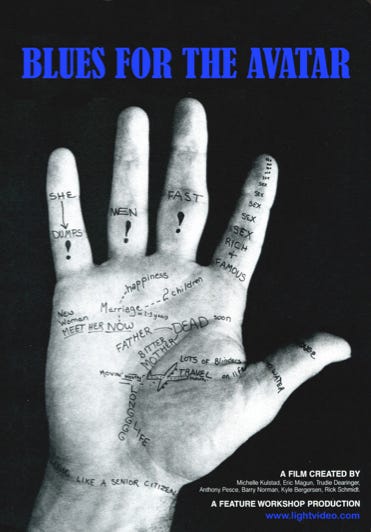BLUES FOR THE AVATAR, shot in Port Townsend, WA (73 min., ©1995), was the inaugural Feature Workshops production. See FULL MOVIE: https://vimeo.com/423780852
TRAILER: https://vimeo.com/ondemand/bluesfortheavatar/>. FILM FESTS: Slamdance/Honorable Mention, Houston Intl./Silver Award , Official Selection-Figueira da Foz Intl.(Portugal).
Of course this first Feature Workshop was a scary proposition, because I had no idea if it would work out! Knowing that five paid participants were heading my way, coming to Port Townsend, made me afraid that I didn’t have enough “story-line” in place as a foundation, no locations set to use, and no cast. That’s when I spotted the house of Partik and Tess Barr, it catching my eye because of the weird part-of-a-ship in their back yard as I was driving around, desperately searching for places to shoot that had something special. Happily, they and their “avatar” daughter became a good half of the cast. And actor Mary Jane Knecht, then working at Copper Canyon press, jumped in as a character who, I envisioned, lived temporarily at the Barr’s house-and in their backyard. She wasn’t at all sure about joining the shoot, but then overcame doubts and threw herself to the wind of performing for us—another lucky break (thanks again Mary Jane!).
And after seeing a play that starred J. Cheyenne Wilbur (I was dragged there by a friend—didn’t usually go to see plays), I almost begged him to be in the movie. I was also fortunate that the cinematographer Kyle Bergersen, from my 1991 production American Orpheus, came aboard—even told a real-life story to the camera(!)—and brought a good sound recordist, Matt Monroe, along! All this and more was going on for the last week before I’d be shooting with complete strangers in the mix
So this is a small part of how it felt for me to create a movie like this out of thin air––dealing with an ever-developing storyline and everyday real (non-actors) people who somehow agreed to be in a fully IMPROV feature film, me praying that we’d have shot enough (good) b&w 16MM footage in 4 days to sync up and cut a feature to at least an hour’s length, before Day-10 (the advertised last day of the workshop) rolled around. (Special thanks to Barry Norman, a participant and future co-producer on several other features including No Tears For Bankers, who helped solidify the cut after the workshop––he and I kicking editorial ideas back and forth––we ultimately delivered a full feature-length movie)
Please enjoy the results!
BLUES FOR THE AVATAR is a comedy about two oddball characters, a man Cheyenne (played by J. Cheyenne Wilbur), and a woman, Mary Jane (played by Mary Jane Knecht), caught in the circumstances of being unwanted guests in other people's lives.
Lead actors J. Cheyenne Wilbur and Mary Jane Knecht
Cheyenne’s propensity for women has landed him in the middle of a horrendous breakup, while Mary Jane’s quest for self-discovery leads her into what might be direct contact with an avatar ('...a spiritual being sent to earth to teach us enlightenment'), Chyna Barr, the young daughter of Tess and Patrik Barr (playing themselves).
Actors Jane Holloway and J. Cheyenne Wilbur.
Many local residents of Port Townsend, WA, became actors in the production, including Stafford Decker, Donn Trethewey, Jane Holloway, Tasha Roth-McCormick, Hank & Stacey Salanoa, Lorna Marvinny, Sylvia Gorsline, others, who appear throughout the film offering real-life stories of irony, outrageousness, and late 20th century angst.
Cast and crew of BLUES FOR THE AVATAR, on-location in Port Townsend, WA)
A collaborative feature written/directed by Rick Schmidt, Kyle Bergersen, Trudie Dearinger, Barry Norman, Eric Magun, Anthony Pesce, Michelle Kulstad. Cinematographer Kyle Bergersen, sound-Matt Monroe, key grip-Karen Rodriguez (see her in American Orpheus), music score-Paul Baker (he also did music for “Orpheus,” song “Blues For the Avatar: written & performed by Tess and Patrik Barr, stills/produ gion assistant-Julie Schachter, titles Terry Tennesen, conforming Andy Pratt, sound mix Len Delorey/Scot Charles (Seattle), editorial consultant-Bob Hawk/ICI, executive producers; Rick Schmidt. Kent Nussbaum, and Barry Norman.
Feature Workshops
In 1993 Schmidt embarked on a series of workshops designed to deliver a feature-length movie in just 10 days, start-to-finish, with collaborators virtually off the street, people armed only with moviemaking interest and a dream. While several of Schmidt's early features were partially scripted, his latter works, Morgan's Cake, American Orpheus and after, became fully improvisational. Relying on neither pre-conceived storylines, nor pre-selected locations or pre-cast actors, he and his collaborators invented feature-length movies on the spot.
One Workshops participant, Barry Norman, not only became one-of-five collaborating writer/directors with Schmidt on the inaugural feature, Blues For the Avatar (Silver Award, Houston International Film Festival, Figueira da Foz International (Portugal), Honorable Mention, Slamdance Film Festival), but has joined Schmidt for several other productions.
Norman was lead actor/collaborator on Rick's Canoe (2004) shot in Santa Fe, NM, co-directed/co-produced by Schmidt and Stephen “Jules” Rubin, as well as starring/co-producing another of Schmidt's full improvisational features, No Tears For Bankers (2012) shot in Rome, GA. The "Schmidt improv" process is well described in a 2012 interview by fellow low/no-budget indie filmmaker Sujewa Ekanayaka (Cosmic Disco Detective Rene, etc.), in "The Films of Rick Schmidt, 1975-2015" (<https://www.amazon.com/Films-Rick-Schmidt-1975-2015-Printing-APPENDIX/dp/B0CGKQL5XL/ref=sr_1_39?qid=1703656139&refinements=p_27%3ARick+Schmidt&s=books&sr=1-39>).
A fourth Norman/Schmidt Feature-Workshop-Style co-production, Sticky Wicket (2013), was shot at Norman's Eveningstar Cinema in Brunswick, Maine, with him again performing the lead role and co-producing. On this feature, Schmidt applied his Workshop techniques to solo directing, shooting and conceiving in a breezy, improv style while still creating traditional storytelling plot points, mannered film cuts, and a concise narrative flow toward an ending/non-ending climax.
The 17 Feature Workshops movies produced to date (over a hundred national and international collaborators involved), along with Schmidt's solo efforts, have been made available online, at both Fandor, Vimeo, and Amazon Prime: <https://www.amazon.com/s?k=rick+schmidt&i=instant-video&crid=G6U3ETMYHD5T&sprefix=rick+schmidt%2Cinstant-video%2C366&ref=nb_sb_noss_1>.
Early Schmidt Films
Rick Schmidt's how-to editions of Feature Filmmaking at Used-Car Prices (<https://www.amazon.com/Feature-Filmmaking-Used-Car-Prices-Revised/dp/014024560X>), in print and revised/updated since the late 1980s, were based on the knowledge he derived from the field, from features he wrote/improvised, directed/co-directed, shot, edited and produced. In 1973 he co-directed A Man, a Woman, and a Killer with his then-roommate Wayne Wang (Chan is Missing, Joy Luck Club, Smoke, Maid in Manhattan, etc.), which won Director’s Choice award at the Ann Arbor Film Festival, 1976. That first feature secured Schmidt a $9.918 AFI production grant for his second feature, Showboat 1988-The Remake (Whitney Museum, 1st Place Award-Ann Arbor Film Festival, London Film Festival, Channel Four/UK). Showboat 1988's artistic worth and LGBTQ motivations have been thoroughly discussed in the book "The Female Complaint," by Lauren Berlin (©2008 Duke University Press.
In 1979, a grant from the National Endowment for the Arts partially funded Schmidt's punk musical comment on 1984, entitled Emerald Cities (FESTIVALS: Rotterdam International, Australian Film Institute’s 7-City Tour, Houston International, etc.) which featured legendary punk bands FLIPPER and THE MUTANTS of San Francisco/Bay Area.
Schmidt's fourth film, Morgan's Cake, a $15,000 improv feature (New Directors/New Films. Berlin International-Panorama, AFI/LA, San Francisco International. etc.), received a Grand Prize nomination as part of the Sundance Film Festival's Dramatic Competition. Critic Janet Maslin’s positive review in the New York Times helped filmmakers believe that they too could do it, inspired by Schmidt's accomplishment on a tiny budget: (<https://www.nytimes.com/1989/03/25/movies/review-film-festival-18-out-of-sync-with-the-world-and-vaguely-disbelieving.html>.
Schmidt's next feature, American Orpheus (Rotterdam International, Seattle International, Figueira Da Foz Intl./Portugal), also an NEA-funded project, was shot on a shoestring at his then-home in Port Townsend, Washington, 1992, followed by his first Feature Workshops feature, Blues For the Avatar, in 1995.








So entertaining (and enlightening) to read how this Feature Filmmaking At Used Car Prices creative approach got launched, and proud that it was here in our hotbed of creativity, Port Townsend! And I love the inclusion of an Avatar, '...a spiritual being sent to earth to teach us enlightenment', which, for me, has a "reality-based' origin. Bravo!